Antioxidant properties of flavonoid derivatives and their hepatoprotective effects on CCl4 induced acute liver injury in mice†
Abstract
Excessive accumulation of free radicals in the body can cause liver damage, aging, cancer, stroke, and myocardial infarction. Anastatin B, a skeletal flavonoid, was reported to have antioxidant and hepatoprotective effects. Anastatin B derivatives, compound 1 and 2, were synthesized by our group previously. In this study, their antioxidant activity and hepatoprotective mechanism were studied using chemical evaluation methods, a cellular model of hydrogen peroxide (H2O2)-induced oxidative damage, and a mouse model of carbon tetrachloride (CCl4)-induced liver injury. Results from the chemical evaluation suggested that both compounds had good antioxidant power and radical scavenging ability in vitro. MTT assay showed that both compounds had cytoprotective activity in H2O2-treated PC12 cells. Moreover, their hepatoprotective activities evaluated using a mouse model of CCl4-induced liver injury that compared with the model group, pretreatment with compound 1 and 2 significantly decreased alanine transaminase (ALT), aspartate transaminase (AST), lactate dehydrogenase (LDH), and malondialdehyde (MDA) levels; reduced the liver tissue damage; and increased glutathione content. However, compound 2 was a more effective hepatoprotectant than compound 1 was. Finally, the amount of TNF-α and cytochrome P450 2E1 (CYP2E1) were significantly downregulated in compound 1 and 2 pretreatment groups. Collectively, our findings demonstrate that both compounds have potential antioxidant activity and hepatoprotective effect in vitro and in vivo. Further chemo-biological study and investigation of the compounds' enzymatic targets are ongoing.



 Please wait while we load your content...
Please wait while we load your content...